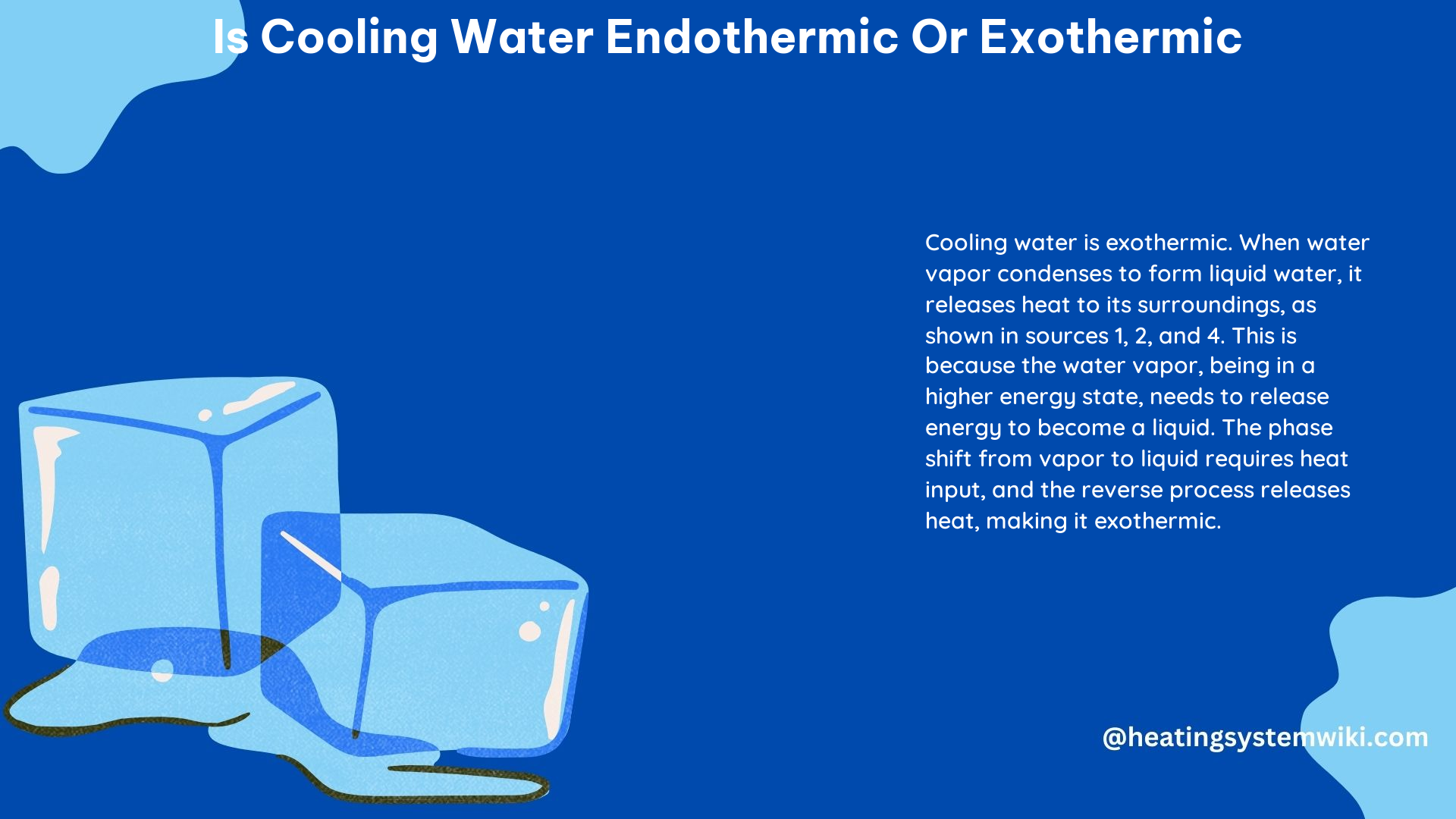Cooling water is an exothermic process, where heat is released from the water into its surroundings, causing the temperature of the water to decrease and the temperature of the surroundings to increase. This is in contrast to an endothermic process, where heat is absorbed by the system, leading to an increase in the system’s temperature.
Understanding the Technical Specifications of the Cooling Process
When water cools down, it can undergo two types of phase changes: liquid to solid (freezing) or gas to liquid (condensation). Both of these phase changes are exothermic processes, meaning they release heat.
Liquid to Solid Phase Change (Freezing)
- During the freezing process, water molecules lose kinetic energy and become more organized, forming a crystalline solid structure (ice).
- As the water molecules lose energy, they release heat to the surroundings, causing the temperature of the surroundings to increase.
- The amount of heat released during the freezing process is known as the latent heat of fusion, which is approximately 334 J/g for water at standard temperature and pressure.
Gas to Liquid Phase Change (Condensation)
- When water vapor (gas) condenses to form liquid water, the water molecules lose energy and become more closely packed.
- This energy loss is released as heat to the surroundings, causing the temperature of the surroundings to increase.
- The amount of heat released during the condensation process is known as the latent heat of vaporization, which is approximately 2,260 J/g for water at standard temperature and pressure.
Cooling Water in a DIY Experiment

Let’s consider a simple DIY experiment to illustrate the exothermic nature of the cooling process:
- Take a container of hot water (e.g., 80°C or 176°F).
- Place the container in a cooler environment, such as a room with a temperature of 20°C or 68°F.
- Observe the water as it cools down over time.
As the hot water cools down, the heat from the water is transferred to the surrounding air or objects, causing the temperature of the water to decrease. This heat transfer is an exothermic process, as the water is releasing heat into its surroundings.
The rate of cooling can be influenced by various factors, such as:
– The temperature difference between the water and the surroundings
– The surface area of the water exposed to the surroundings
– The thermal conductivity of the container material
– The air circulation or convection in the surrounding environment
By monitoring the temperature of the water and the surrounding environment over time, you can observe the exothermic nature of the cooling process.
Quantifying the Cooling Process
To further understand the exothermic nature of the cooling process, we can quantify the heat transfer using the following equation:
Q = m × c × ΔT
Where:
– Q is the amount of heat transferred (in Joules, J)
– m is the mass of the water (in grams, g)
– c is the specific heat capacity of water (4.184 J/g°C)
– ΔT is the change in temperature (in degrees Celsius, °C)
For example, if you have 500 grams of water that cools down from 80°C to 20°C, the amount of heat released can be calculated as:
Q = 500 g × 4.184 J/g°C × (80°C – 20°C)
Q = 500 g × 4.184 J/g°C × 60°C
Q = 125,520 J
This demonstrates that the cooling process is exothermic, as the water releases a significant amount of heat (125,520 J) to the surroundings.
Conclusion
In summary, cooling water is an exothermic process because it releases heat into its surroundings. This heat transfer occurs during phase changes, such as freezing (liquid to solid) or condensation (gas to liquid), as well as during the gradual cooling of water in a warmer environment. By understanding the technical specifications and quantifying the heat transfer, we can clearly see that the cooling of water is an exothermic process.
References:
- Is heating water endothermic? – Chemistry Stack Exchange, 2019-04-11, https://chemistry.stackexchange.com/questions/112575/is-heating-water-endothermic
- Which of the following processes are exothermic? Which ones are endothermic? Justify the answer. – Study.com, https://homework.study.com/explanation/which-of-the-following-processes-are-exothermic-which-ones-are-endothermic-justify-the-answer-a-burning-gasoline-b-freezing-ice-cream-c-melting-chocolate-d-cooling-hot-water-e-condensing-water-vapor-f-burning-a-match.html
- Can someone explain how something getting cooler is endothermic? – Reddit, 2023-04-11, https://www.reddit.com/r/chemhelp/comments/12j2a58/can_someone_explain_how_something_getting_cooler/
